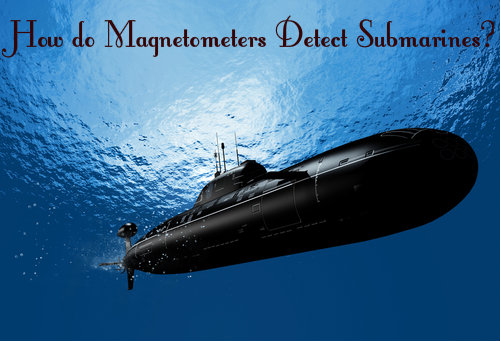Magnetometers can be used to measure the magnetization of an object, or to give information about a magnetic field nearby. A magnetometer can be used as a powerful but selective metal detector that responds only to magnetic metals, while handheld metal detectors have limited range, which is why their users can spend hours combing a small area for treasures. On the other hand, magnetometers can scan an area for large objects at great distances.
Air magnetometers are flown across the ocean to pick up signals from beneath the surface of the water. Once a submarine is underwater, it’s difficult to see from above, however it will emit a distinct signature that’s picked up by the magnetometer. It’s so useful strategically that the National Defense Research Council created the Magnetic Anomaly Detector (MAD) for use in reconnaissance.
The Earth emits a magnetic field at all times, and this magnetic field is responsible for pointing the arrow on a compass north. When a magnetic object pass through, it disrupts the magnetic field from the earth, leaving a distinct imprint of its profile. Submarines are made with magnetic metals, and regardless of depth, it will be detected by a magnetometer flying from above.

The fluxgate principle uses a simple setup to detect magnetic forces. Two coils are wrapped around a magnetic object, such as an iron core. Electricity (AC) is passed through one of the coils, forcing the iron core to experience alternating magnetization. The second coil experiences an electrical current which should differ in magnitude from the electric current in the first coil. The difference is an in indicator of magnetic forces nearby.
The magnetometer can be modified to include detailed measurements. There are 2 general types of magnetometers: vector magnetometers provides a breakdown of direction and strength of the force from the magnetic field, while a scalar magnetometer simply provides the net amount of the force exerted. A scalar magnetometer is enough to detect underwater submarines.
Since the development of MAD in 1942, the magnetometer has changed considerably. Additional features and refined specifications include:
- Varying sample rates, which report readings per second
- Bandwidth/band pass shows how well the magnetometer is reading a fast moving object
- Resolution describes the level of detail that the magnetometer can detect
- Absolute error is instrument error that on average the magnetometer will experience
- Drift is the absolute error as a function of time
- Noise is the emissions from the instrument itself that’s included in the reading of external magnetic forces
- Heading error occurs when the direction of the magnetometer changes
Even before the advent of these advanced technologies, magnetometers were very successful in detecting submarines from above. As soon as it became operational, it was able to find an enemy submarine when one was flown over the Mediterranean.
The magnetometer is so effective, it can be used over land to detect ferrous materials. Various mining companies have used the flux magnetometer to search for ore.
Author bio:
Michael C Nelson blogger and an automobile freak with strong passion for new technology. He’s written about the industry since 2009. Apart from his profession, he is a keen automobile enthusiast with a passion for vintage cars. Follow him at Twitter or Google +
